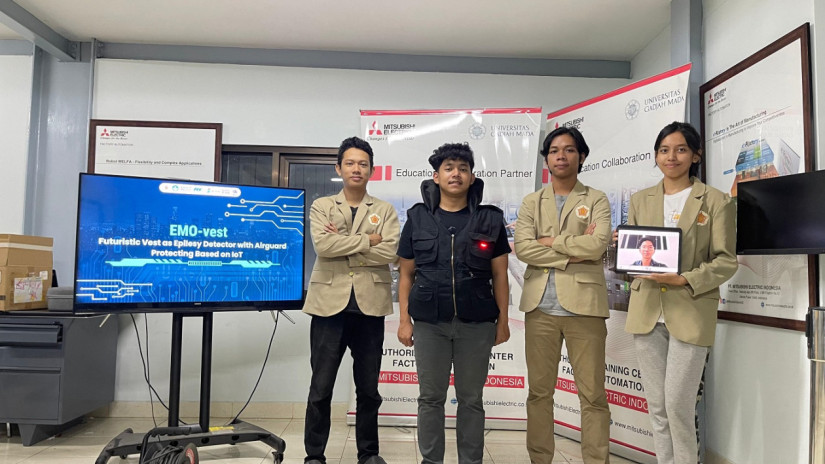
One of the Student Creativity Program in Intellectual Creation (PKM-KC) teams from Universitas Gadjah Mada has developed a monitoring and protective device for epilepsy patients called EMO-vest, integrated with the Internet of Things (IoT). This vest-shaped device is designed to facilitate use for individuals with epilepsy.
The EMO-vest team consists of Frengki Prabowo Saputro Wijayanto, Artha Maressa Theodora Simanjuntak (Faculty of Medicine, Public Health, and Nursing/FK-KMK UGM), Muhammad Raihan Tsani, Gamma Nasim (Faculty of Engineering/FT UGM), and Haydar Amru Revanda (Faculty of Mathematics and Natural Sciences/FMIPA UGM).
The EMO-vest team, guided by Dr. Noor Akhmad Setiawan, received funding from the Ministry of Education.
Frengki Prabowo Saputro Wijayanto, the team leader, explained that the development of this device stems from the high incidence of death among epilepsy patients during seizures. He recounted witnessing an epileptic episode before starting university, where he saw a man fall and have a continuous seizure.
“I felt panicked and had no knowledge of first aid at that time,” Wijayanto said at UGM on Thursday (Jul. 18).
According to articles he read, Wijayanto added if epilepsy patients do not receive immediate assistance during a seizure, it could result in death due to a lack of oxygen supply, leading to heart complications.
“Currently, epilepsy cannot be cured but can be managed with Anti-Epileptic Drugs (AEDs) to minimize the frequency of seizures,” Wijayanto explained.
Gamma Nasim, a team member, mentioned that with the development and use of EMO-vest, epilepsy patients can travel independently without worry.
As the person responsible for designing the electronic system and all sensors in the EMO-vest device, he explained that the vest will detect when the patient falls and experiences a seizure.
The device will then send an SMS containing the patient’s location information. This information is also sent via SMS, WhatsApp, and phone calls.
“Additionally, the EMO-vest will emit a sound indicating that the patient is in an emergency and needs to be taken to the hospital immediately,” Nasim elaborated.
Muhammad Raihan Tsani added that the EMO-vest also has an automatically inflated airbag that deploys before the user falls. This airbag will protect the user’s body, especially vital areas.
“Moreover, there is a first aid guide for epilepsy located in the vest’s pocket,” Tsani, responsible for the airbag system, said.
EMO-vest has a social media presence on Instagram, X/Twitter, Facebook, TikTok, and YouTube. One of their usernames is @pkmkcugm_emovest on Instagram, where users can visit to learn more about the device.
“On our social media, we provide information about epilepsy and its classifications, the dangers of epilepsy, and details about the device. We also update our progress weekly on Instagram. The link to other social media platforms is available in our Instagram bio,” said Artha Maressa Theodora Simanjuntak, the team member responsible for social media and testing the device on simulated patients.
Simanjuntak noted that the team of five students from various disciplines faced some challenges, including scheduling conflicts and busy activities outside the PKM-KC project.
“We had to find time to meet and discuss,” she said.
Haydar Amru Revanda echoed similar sentiments, mentioning that the main issue was the lack of direct meeting time due to different faculty schedules and personal commitments.
“Despite this, we always meet at least once a week to discuss our device’s progress,” said Revanda, who is responsible for the SMS, GPS modules, and component assembly.
This project is hoped to advance science and technology, particularly in the medical field, and to assist epilepsy patients in Indonesia.
With this device, the EMO-vest team aims to contribute to sustainable development, particularly concerning SDG 3 (Good Health and Well-Being) and SDG 9 (Industry, Innovation, and Infrastructure).
Author: Agung Nugroho
Contributor: UGM EMO-vest Team

